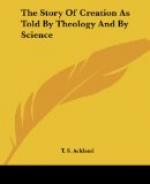We come then to the theory of Evolution with which Mr. Darwin’s name is associated. This theory asserts that all the varieties of animal life now existing on the earth, however widely they may differ from each other, are in reality derived from one, or a very few original types; and that in this general statement the human race is to be included. This theory rests upon the following admitted facts.
1. There are not, as was at one time commonly supposed, broad and distinct lines of demarcation between the different varieties of animals and plants. Our increasing knowledge of zoology has brought to light the fact that one species shades off into another by almost imperceptible gradations. As we go back in the fossil records of animal life in the past, we find that the species now existing, while they are closely allied to correspondent species of an earlier period, are scarcely ever identical with them, and that the few cases of identity which do occur, are limited to the most recent rocks. Either then the old species must have perished, and new ones, similar but not identical, must have been created to take their places, or there must have been a process of gradual change, by which the present species have been derived from their predecessors. In one or two cases fossils have been found which combine, to some extent, forms which are now found in distinct species, as if the process of variation had proceeded in distinct lines from a common source.
2. No two animals of any class are exactly alike in all points. Each has its individual peculiarities, and in some cases these peculiarities are strongly marked.
3. Man has been enabled, to a certain extent, to make use of these individual peculiarities, and by means of them to produce great varieties in the breeds of domesticated animals. This has been sometimes done unconsciously through a selection influenced by other motives, and then the process has been very slow; but latterly intentionally, with a view to the production of improved breeds, and whenever this has been the case, changes of considerable extent have been rapidly produced. By carefully selecting the animals to be paired, any desired modification can generally be produced in the course of a few generations. This is exemplified in the numerous and increasing varieties of the breeds of almost all domestic animals and birds.




